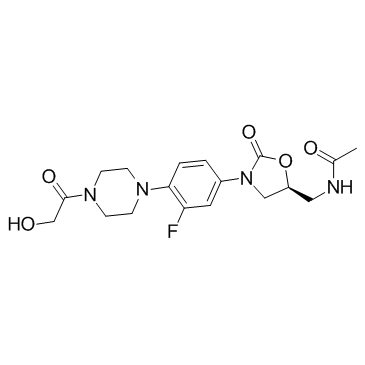| Cas No.: | 165800-04-4 |
| Chemical Name: | Acetamide, N-[[(5S)-3-[3-fluoro-4-[4-(2-hydroxyacetyl)-1-piperazinyl]phenyl]-2-oxo-5-oxazolidinyl]methyl]- |
| Synonyms: | PNU-100592;PNU100592;U-100592 |
| SMILES: | FC1=C(N2CCN(C(=O)CO)CC2)C=CC(N2CC(CNC(=O)C)OC2=O)=C1 |
| Formula: | C18H23FN4O5 |
| M.Wt: | 394.3974 |
| Purity: | >98% |
| Sotrage: | 2 years -20°C Powder, 2 weeks 4°C in DMSO, 6 months -80°C in DMSO |
| Description: | Eperezolid(PNU-100592) is a oxazolidinone antibacterial agent, Eperezolid demonstrated good in vitro inhibitory activity, regardless of methicillin susceptibility for staphylococci(MIC90= 1-4 mg/ml).Eperezolid binds specifically to the 50S ribosomal subunit of Escherichia coli. The specific binding of eperezolid is dose dependent and is proportional to the ribosome concentrations. Scatchard analysis of the binding data reveals that the dissociation constant (Kd) is about 20 microM. The binding of eperezolid to the ribosome is competitively inhibited by chloramphenicol and lincomycin. However, unlike chloramphenicol and lincomycin, eperezolid does not inhibit the puromycin reaction, indicating that the oxazolidinones have no effect on peptidyl transferase [2]. eperezolid was found to bind only to the 50S subunit, with similar affinity as to the 70S ribosome, and to have no affinity for the 30S subunit [3]. |
| Target: | IC50 value: 1-4 mg/ml (MIC90, staphylococci) [1] Target: Antibiotic |
| References: | [1]. Rybak MJ, et al. Comparative in vitro activities and postantibiotic effects of the oxazolidinone compounds eperezolid (PNU-100592) and linezolid (PNU-100766) versus vancomycin against Staphylococcus aureus, coagulase-negative staphylococci, Enterococcus f [2]. Lin AH, et al. The oxazolidinone eperezolid binds to the 50S ribosomal subunit and competes with binding of chloramphenicol and lincomycin. Antimicrob Agents Chemother. 1997 Oct;41(10):2127-31. [3]. Zhou CC, et al. 1H nuclear magnetic resonance study of oxazolidinone binding to bacterial ribosomes. Antimicrob Agents Chemother. 2002 Mar;46(3):625-9. |

 To enhance service speed and avoid tariff delays, we've opened a US warehouse. All US orders ship directly from our US facility.
To enhance service speed and avoid tariff delays, we've opened a US warehouse. All US orders ship directly from our US facility.





















